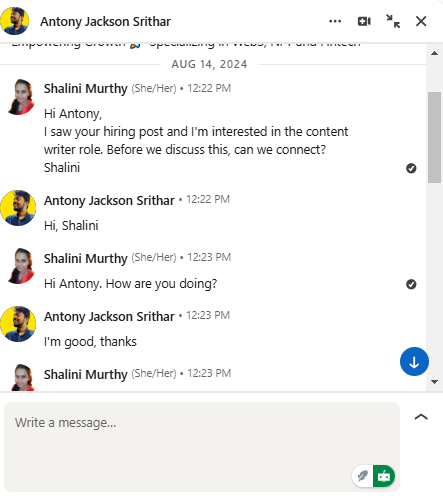LinkedIn Hacks: 3 Proven Strategies That Actually Work (2025)
- shalini murthy
- Jan 30
- 4 min read
Updated: Jan 31
For the longest time, I thought I knew LinkedIn. Create content, share posts, connect with people—how hard could it be? I couldn't have been more wrong.
I spent eight months getting it all wrong. Every morning, I'd head to my favorite café, order my usual coffee, and spend hours creating content calendars, organizing Trello boards, and brainstorming content ideas. I was doing everything the "experts" said I should do. Yet, the needle barely moved.
Then something changed.
Between the countless cups of coffee and late afternoon strategy sessions, I started noticing patterns. LinkedIn wasn't just another social media platform; it was an entire ecosystem I had been using at 10% of its potential.
Look, I'm not here to overwhelm you with 30+ LinkedIn hacks that might work. Instead, I want to share three specific strategies that I still use daily and see consistent results from. These are approaches I've personally used and refined through months of real-world experience.
LinkedIn hack 1: The Connection Strategy That Changed Everything
The first breakthrough came when I completely reversed my approach to connections.
Here's the thing: I used to send personalized connection requests to everyone I wanted to network with. Sounds right, doesn't it? But as a free LinkedIn user, I quickly hit walls with the platform's limitations.
So I tried something different.
Instead of immediately trying to connect, I started following people whose content genuinely resonated with me.
I'd spend time understanding their perspectives, engaging with their posts, and adding real value to discussions. Not just with quick "Great post!" comments, but with thoughtful insights and relevant experiences.
The results?
These amazing people responded to my DM and eventually accepted my connection request. My connection acceptance rate shot up to 90%.


Jasmin Alic was right after all: "LinkedIn is not a B2B platform. Or B2C. It's H2H = Human to Human. Forever."
People remembered me. They engaged back. We started having meaningful conversations.
LinkedIn hack 2: The Job Search Hack That Landed Me the Head of Content Role
The second strategy is ridiculously simple, yet it completely changed my job search game.
What if I told you one search trick could connect you directly with decision-makers who are actively hiring content professionals?
Here it is:
Type "Looking for content*" in LinkedIn's search bar.

That's it.
This simple search reveals a goldmine of opportunities—from direct hiring posts to job listings that haven't hit the mainstream job boards yet. But knowing the search trick is only half the battle.
Here's how I leverage it effectively:
First, I scan through posts and apply strategically. This isn't about sending your resume everywhere. I've developed a careful vetting process:
I thoroughly check the poster's profile and posting history
I evaluate the compensation (and skip those unpaid or minimal-pay opportunities)
I analyze the post quality and verify the company's legitimacy
Whenever possible, I apply via email; it helps me stand out from the LinkedIn application flood
This exact strategy led to multiple interviews and ultimately landed me my current role.
Remember: In today's job market, it's not just about what you know or who you know—it's about who knows what you know. This search hack helps you get on the radar of the right people at the right time.
LinkedIn hack 3: Building Strategic Connections That Lead to Opportunities
The third hack builds on the power of that same search trick, but with a different angle. Instead of just looking at job posts, I scan through the search results for people who are actively hiring content roles that match my expertise.
When I find someone whose team or company aligns with my goals, I take a direct approach. I send them a simple DM introducing myself along with my portfolio. No complex pitch, no lengthy messages—just a straightforward introduction expressing my interest in potential opportunities.


This approach is powerful because:
You're reaching out to people who are already in an active hiring mindset
You're showing initiative by making the first move
Your portfolio immediately demonstrates your capabilities
You might learn about roles before they're publicly posted
The beauty of this strategy is its simplicity. While others are waiting for job postings to appear, you're having direct conversations with decision-makers. I've found that even when there isn't an immediate opening, many hiring managers keep promising candidates in mind for future opportunities.
The Reality Check
Here's the truth: LinkedIn success isn't about knowing every feature or hack.
It's about understanding how to use the platform to build genuine professional relationships.
These three strategies work because they focus on what LinkedIn does best—connecting professionals meaningfully.
I still use these same approaches today. Between content creation, strategy sessions, and client work, these remain my go-to tactics for growing my professional network and opportunities.
Will these strategies take more time than mass-sending connection requests or blindly applying to jobs?
Yes.
Will they yield better results?
Absolutely.
The choice is yours – you can keep using LinkedIn like everyone else, or you can start using it to its full potential. These three strategies are your starting point. They worked for me, and they can work for you too.
What's your LinkedIn strategy looking like? Have you tried any of these approaches? I'd love to hear your experiences.




Comments